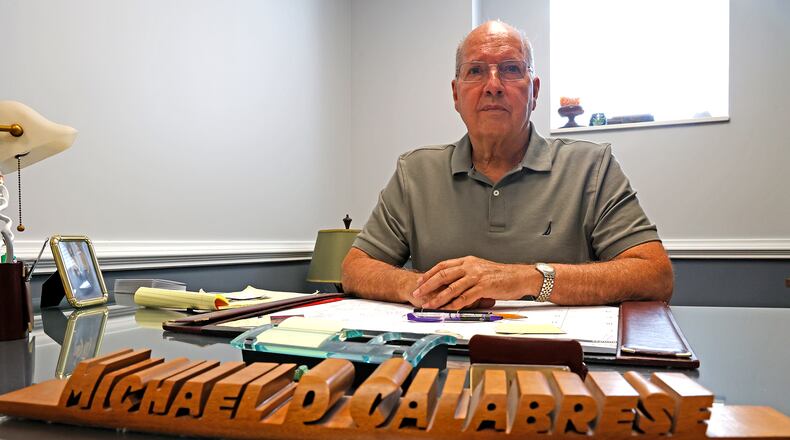Mike Calabrese, OIC executive director, said getting the charges can be a gateway to a “criminogenic lifestyle.”
“The way that happens is that a kid gets pulled over for driving without a license. He’s pulled over for an infraction, and he doesn’t go to court,” Calabrese said. “So then a warrant is issued, and now he may be an adult — he may now be 18 years old and not in the juvenile system, but that follows him.”
Clark County Juvenile Court Judge Katrine Lancaster said “the fastest way into the criminal justice system” is driving without a license. She said it can act as a “gateway” into the adult court system.
How pervasive is the issue?
From January to June of this year, 30 minors were charged with driving without a license. In 2022, there were 54 for the whole year, and in 2021, there were 52. In 2020, 91 minors faced the charge.
Fewer teens teens were charged with driving with a suspended license, with three in 2020, there in 2021, two in 2022 and one so far this year.
Under Ohio law, teens must obtain their instruction permit, which is allowed for people 15 1/2 and older, by passing a written test and registering for a licensed driving education class, before they become eligible to take their driving license test. They must obtain at least 50 hours of supervised driving with a licensed guardian, with 10 hours at night.
After at least six months, they can take an on-the-road driving test to receive a probationary license, which allows a teen driver to drive alone with several restrictions. This license is in effect until a driver turns at 18, when they can obtain their full license.
Adults becoming licensed drivers are still required to obtain a temporary permit, but they can drive with a licensed adult over the age of 21 and do not have to wait six months before taking the road test. They can take the road test without driver’s education classes.
Some individuals may need to drive in order to get to jobs necessary to support their families, but once caught and found responsible for driving without a valid license, they must pay expensive fines and later higher costs to obtain valid licenses once the law allows after such an offense, Lancaster said.
People faced with these charges have to attend court hearings, where they may also be held responsible for court costs. She said those who cannot afford driving school can afford being caught driving illegally even less.
“If you don’t show up for court hearings with those you can end up with warrants,” Lancaster said. “If you end up with a warrant, and then you’re detained in the jail, that then reduces your ability to get employment. It just becomes a spiral.”
Calabrese said he noticed this was a common occurrence when OIC, a nonprofit that aims to address the needs of community members at or below the poverty line, operated the Clark County Reentry Coalition.
Driving school prohibitively expensive for many teens
At Springfield’s School of Driving, all driving courses for teens cost at least $495. According to the Ohio Department of Public Safety’s website, this is the only certified school in Clark County. A certified school in Urbana appears to be closed.
“When you look at a kid where they’re from a marginalized income household, $500 is almost impossible to come up with,” Calabrese said.
Lancaster said illegal driving is often a teen’s first offense. She said most of the minors who she works with at the juvenile court do not have their driver’s licenses.
“You put that on the parent because the child typically isn’t able to afford it,” Lancaster said. “Some of them might be working, but that’s still a lot to have to pay for that.”
Credit: Bill Lackey
Credit: Bill Lackey
Some of the individuals that Lancaster sees in court cannot legally obtain their driver’s licenses because their parents cannot teach them to drive due to issues with their own licenses or not having the time to teach their child on the road, she said.
Teens driving without a license can have more serious immediate consequences as well, Lancaster said. Many individuals are speeding or driving unsafely because they have not learned best practices, and they may end up injuring or killing someone or themselves, she said.
“I have three boys and I helped teach them how to drive, and it was my first one that definitely taught me that just because you sit in the car and you’re sitting in the front doesn’t mean you know what the rules are,” Lancaster said. “Like you can’t turn left on a light where there’s other people. You don’t have that right-of-way. If you don’t know that, you don’t learn those rules ... one of the benefits of having gone through and taken the test as a younger person (is) you know what the rules are.”
According to the National Highway Traffic Safety Administration, new teen drivers are twice as likely as adults to be involved in a fatal crash. From 2012 to 2021, there was a 13% increased in passenger vehicle driver deaths of 15- to 18-year-olds.
Should governments fund driving schools?
A nonprofit driving school funded by the Springfield and Clark County governments would be a good solution for the issue, Calabrese said. It would be difficult to find the right funding source that would allow the majority of teens to participate, though, he said.
“What OIC proposed was that the city and the county consider jointly funding a nonprofit driving school for low-income kids and it would be based on the federal poverty guidelines,” Calabrese said. “It could be on a sliding scale; the more income, the more the child would have to pay, all the way down to if they were far below the poverty guideline, then there would be no charge.”
Ohio Gov. Mike DeWine recognized the challenges driving school costs can create for many teens, creating a scholarship program in December to send minors to driving school at low or no cost. The Springfield-Clark County Career Technology Center received $30,000 for Clark County teens.
Most high schools in Ohio no longer offer driver’s education courses, largely due to budget cuts, but this would be the best solution for the problem, Lancaster said.
Lancaster said it’s critical for teens to learn to drive through an experienced expert to avoid legal or devastating life consequences.
“You’ve got the gateway into the criminal side, but then you also have that safety component, and that’s really important — particularly when we’re talking about the younger kids I’m working with,” Lancaster said. “And the ones I’m working with, there’s I think a lack of understanding of the power of the vehicle. They may recognize (it) but then they see some movie with a big car chase and think ‘That looks pretty exciting.’”
About the Author



